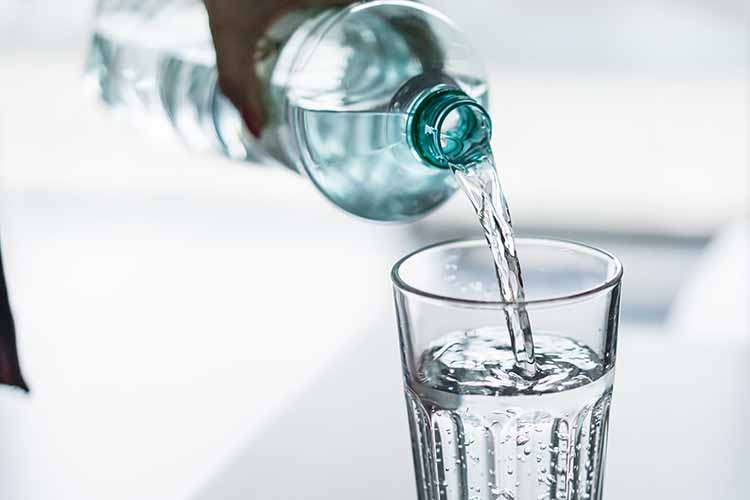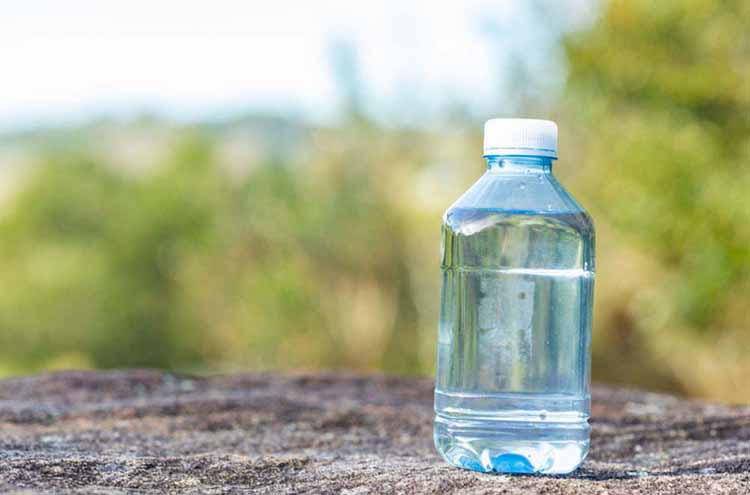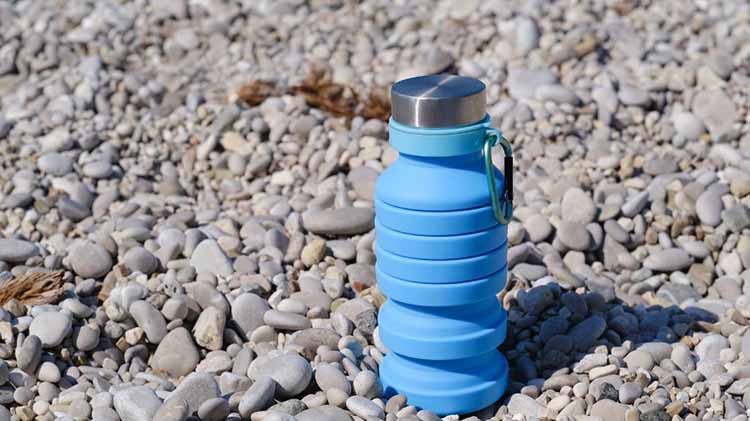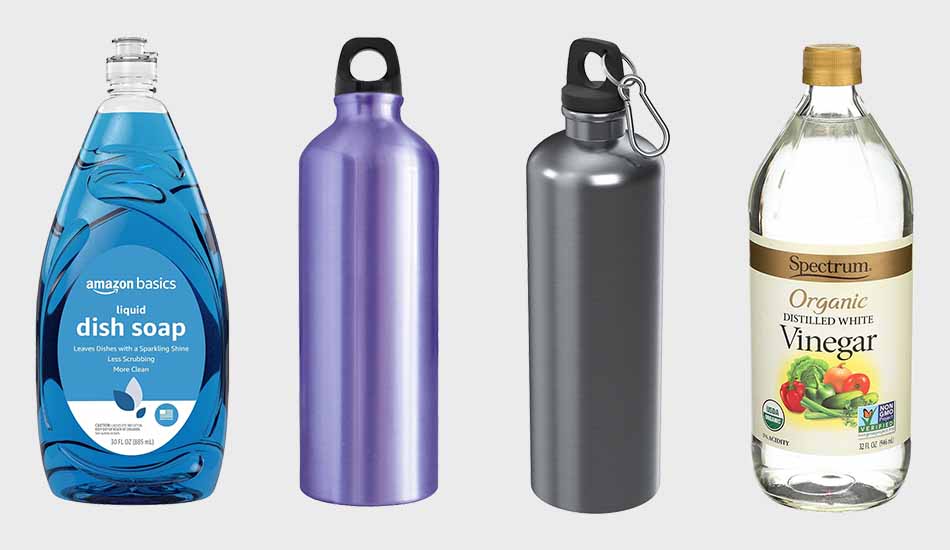We know how annoying it is to notice a funky smell or a stubborn residue in your water bottle. It’s also a sign that you’re compromising your health by neglecting bacterial buildup in your water bottle.
So, how to clean a water bottle?
There can be multiple answers depending on whether it’s about regular cleaning or deep cleaning a water bottle. For example, you can use warm water with soap to clean a bottle regularly. However, you will need a stronger cleanser, such as baking soda or vinegar to deep cleaning the bottle.
Scroll down to have a detailed idea about how to clean a water bottle and ensure safe hydration.

How to Clean A Water Bottle- A General Cleaning Procedure
Before heading into how to deep clean a water bottle, know how you should treat your water bottle daily.
Materials Needed
- Dishwashing soap (liquid)
- Paper towel
- Bottlebrush
Step 1: Fill with Warm Water and Dish Soap
First off, fill your water bottle with warm water and add a squirt of dishwashing liquid.
If your bottle has multiple parts, such as a removable cap or straw, separate them before cleaning. Secure the cap back on the bottle and give it a good shake. This helps loosen any dirt or residue inside the bottle and makes cleaning it easier.
Step 2: Scrub the Inside
Next, remove the cap and use a bottle brush to scrub the interior walls and bottom of the bottle.
Clean the bottle’s lip; this is the hotspot of germs and bacteria. Invest in a bottle brush, it will help reach spots that are hard to get with just shaking. Scrubbing will remove any stuck-on grime effectively and leave your bottle spotless.
Step 3: Clean the Cap
Don’t forget to clean the cap or lid of your water bottle just as thoroughly as the bottle itself. Use warm water and dishwashing liquid to scrub the lid. Pay special attention to any crevices and the mouthpiece where bacteria can have a shelter.
Step 4: Rinse and Dry Completely
After scrubbing, rinse the bottle and cap thoroughly using warm water to remove all soap residue. Make sure no soap bubbles remain, as they can affect the taste of your water and aren’t safe to ingest.
Dry the bottle with a clean paper towel or dish towel. This will prevent bacteria from growing in the moisture. If you prefer air drying, leave the cap off to allow proper airflow and avoid trapping moisture inside.

How to Deep Clean a Water Bottle With Baking Soda
So, why do you even need to deep clean a water bottle?
If you haven’t cleaned the bottle for quite a long time and it has developed an unpleasant odor, it’s time for a deep clean. Follow these steps to deep clean your water bottle.
Materials Needed
- Baking soda
- Water
- Bottle cleaning tablets (optional)
Step 1: Prepare the Cleaning Solution
Add one teaspoon of baking soda to your bottle. Fill the bottle with cool water and allow the solution to react and break down grime and bacteria. Let this mixture sit overnight to ensure it effectively cleans all the nooks and crannies.
Step 2: Rinse Thoroughly
Rinse the bottle the next morning. Use warm water to wash out all the baking soda residue. Make sure to rinse multiple times until you can no longer detect any cleaning solution.
This step will ensure no baking soda remains, which could affect the taste of your water and be harmful if ingested.
Step 3: Dry Completely
Whether there will be bacterial growth or not will depend on how well you dry your bottle.
Use a clean paper towel or dish towel to dry the inside and outside of the bottle. If you prefer air drying, remove the cap and let it dry separately. It will allow complete drying and avoid moisture buildup
You can also run dishwasher-safe bottles through a dishwashing cycle for added sanitation.
This is how you can deep clean a water bottle using baking soda. You can also use bottle-cleaning tablets in this process, which can magically help remove odour and grime.
Recommended: Best Green Water Bottles
How to Deep Clean a Water Bottle With Vinegar
If you’re looking for a natural cleaning solution, vinegar is an excellent choice due to its affordability and non-toxic properties.
Materials Needed
- Vinegar
- Water
- Paper towel
Step 1: Fill with Vinegar and Water
Fill your water bottle halfway with white vinegar. Then, add cool water until the bottle is full. The high acetic acid content in vinegar effectively kills bacteria. Allow this mixture to sit in the bottle overnight to ensure it thoroughly cleans and disinfects.
Step 2: Rinse and Dry
Now, thoroughly rinse out the vinegar and any loosened grime. Rinse multiple times to remove all traces of vinegar, as any remaining can affect the taste of your water.
Use a clean dishcloth or paper towel to dry the inside and outside of the bottle. If your bottle is dishwasher safe, you can run it through a cycle for additional sanitation.

Cleaning Different Types of Water Bottles
Since there is more than one type of water bottle, you should know the right way to deal with different materials.
Plastic Water Bottles
Plastic water bottles are convenient but can easily harbor bacteria and odors if you don’t clean them properly. Follow the above-mentioned procedures for general and deep cleaning of the bottle.
Avoid using bleach, as it can degrade the plastic. Make sure the bottle is completely dry before storing it to prevent mould growth.
Stainless Steel Water Bottles
Stainless steel water bottles are durable and resistant to bacteria buildup but still require regular cleaning.
Use warm water and dish soap, scrubbing the inside with a bottle brush. For stubborn stains or odors, fill the bottle with vinegar and water, let it sit for a few hours, and then rinse thoroughly.
Do not use abrasive cleaners or brushes that may scratch the surface. Always dry the bottle completely after washing.
Glass Water Bottles
Glass water bottles are easy to clean and don’t retain odors or stains. However, they are fragile, so be extra careful while cleaning them.
Use warm water and dish soap for regular cleaning, and a bottle brush to reach the bottom. For deeper cleaning, follow the baking soda procedure.
Avoid using very hot water to prevent thermal shock and potential cracking. Dry the bottle properly so there’s no moisture left.
Insulated Water Bottles
Insulated water bottles require careful cleaning to maintain their insulation properties.
Use warm water and dish soap for daily cleaning. For deep cleaning, use vinegar solution as we suggested in our guides.
Do not submerge the entire bottle in water, as this can damage the insulation. Rinse thoroughly and dry completely.
Recommended: Insulated Water Bottles With Handles
How to Clean Reusable Straws
Reusable straws can be a place for germs and bacteria if left unclean for a long time. Here’s what you can do to prevent it from happening.
- Rinse the straw using warm water to remove any remaining liquid or debris.
- Now, use a straw cleaning brush or pipe cleaner with warm, soapy water to scrub the inside and outside of the straw.
- Mix one part water with one part white vinegar to prepare a natural disinfectant solution.
- Place the straw in the vinegar solution and let it soak for a few minutes to sanitize.
- Rinse the straw thoroughly with warm water to remove any vinegar residue.
- Air-dry the straw before you use it again. To do so, you can place it in a clean, dry area with good airflow.
How Often to Clean Water Bottles?
It’s a must to clean your water bottles regularly to make the drink inside them safe.
The general cleaning procedure should be in your daily routine. It’s better to deep clean the bottle once a week. Also, try to clean the bottle more frequently on the days when you are ill. It’s because the bottle is more prone to be a shelter for bacteria and germs when you are sick.
Bonus Tips to Make A Bottle Last Long
Let’s get to know some additional tips or cleaning practices that will make your bottle last longer.
- Be careful about regular cleaning and deep cleaning. It will help the bottle stay free from germs, stains, and odors.
- Avoid using harsh chemicals such as bleach to clean your bottle, or they will degrade it soon.
- It’s important to dry the bottle completely after each wash to prevent mold and bacteria growth.
- Store the bottle in a cool and dry place with the cap off.
- Don’t expose your bottle to extreme temperatures. Don’t leave it in direct sunlight or use it with very hot liquids unless designed for it.
- Always follow the care instructions provided by the manufacturer, particularly regarding dishwasher use and cleaning methods.
FAQs
Can You Boil Your Water Bottle to Clean It?
Yes, you can boil some water bottles to clean them, but it depends on the material. Boiling works well for stainless steel and glass bottles. Do not boil plastic bottles, as it can damage them. Boil the bottle for about five minutes. This will kill bacteria and germs.
How to Clean a Moldy Water Bottle?
To clean a moldy water bottle, fill it with a mixture of warm water and a teaspoon of baking soda or white vinegar. Let it sit for a few hours. Scrub the inside with a bottle brush. Rinse thoroughly with hot water. Dry completely before using it again. This method removes mold and disinfects the bottle.
How Do You Clean a Sticky Water Bottle?
Soak a cloth in warm, soapy water and white vinegar. You can use a nail polish remover as an alternative to vinegar here. Place the cloth over the sticky area and let it sit to dissolve the residue. The soaking time will depend on how sticky the bottle is. After soaking, wipe away the solution and the residue with the cloth. Rinse the bottle using warm water dry it completely.
Last Thoughts
This is where our discussion about how to clean a water bottle ends. We hope that cleaning a water bottle is not a hard nut to crack for you anymore.
Be careful when dealing with hot water or chemicals while cleaning your water bottle. Practice daily cleaning and deep cleaning to have a longer journey with your water bottle. Also, regularly inspect for damage or cracks so you can replace the bottle as soon as it requires a change.
Happy cleaning!

